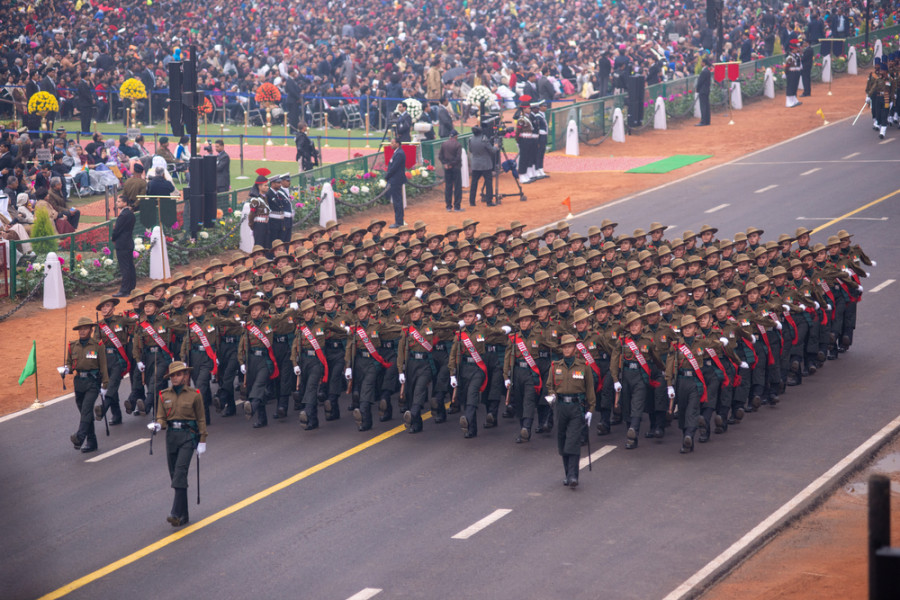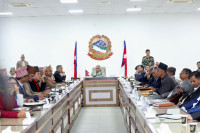National
Nepal avoids raising disputed Agnipath scheme at foreign secretary-level talks in New Delhi
The meeting discussed boundary matters, energy cooperation, trade and transit, and the construction of LPG pipeline, among other things.
Anil Giri
Foreign secretaries of Nepal and India met in New Delhi on Tuesday and discussed issues ranging from boundary matters to energy cooperation. The meeting also discussed a review of the Treaty on Trade and Transit and construction of a liquefied petroleum gas pipeline from Motihari, India to Chitwan, among other things.
However, the statements issued by the Nepali Embassy and India’s Ministry of External Affairs have no mention of the Nepali youths recruitment in the Indian Army under the Agnipath Scheme which currently remains stalled after reservations by Nepal over the short service period for recruits. The new scheme launched by the Narendra Modi government has reduced the service period for recruits to four years.
“We did not raise the issue because we have yet to hold political consultations at home before discussing it with the Indian side,” a Nepali member of the delegation at the meeting said.
“But through various other channels, we have communicated to India that recruitment should be carried out as per the spirit of the 1947 tripartite agreement between Nepal, then British and Indian governments. We have also communicated our reservations to the Indian side that our people might not be interested in a short-term service. And those who retire after four years may pose a security threat and its social cost might be high,” the official said.
Recruitment of Nepali youths under the scheme remains halted after Nepal last month refused to give its approval. And on August 23, Foreign Minister Narayan Khadka told Indian ambassador Naveen Srivastava that Nepal would make a position regarding the scheme after consulting political parties and other stakeholders. But the government has not held such consultations yet.
Under the scheme, the Indian government will recruit “Agniveers” who will be released from service after four years. The provision will also be applicable to those serving under the Gorkha regiments, a dedicated force of the Indian Army that hires only Nepali nationals and Nepali-speaking people. A Nepali official said that Nepal has sought further clarifications on the scheme from the Indian side.
During the meeting Tuesday held at the invitation of Indian Foreign Secretary Vinay Mohan Kwatra, in Hyderabad House, the officials expressed satisfaction at the progress made in different areas including the power sector, construction of transmission lines, railway connectivity, construction of integrated check posts, motorable bridges and other important infrastructure, according to a statement issued by the Nepali Embassy in New Delhi. The Nepali delegation was led by Foreign Secretary Bharat Raj Poudyal.
They also discussed early conclusion of the Transit Treaty including its Protocol and the Memorandum to the Protocol and expediting the review of the trade treaty, the statement added. The Nepali side also raised matters related to fertiliser supply, and waiver of the Indian export restrictions on wheat, sugar, paddy, and rice grains. In the wake of the Russia-Ukraine war, India has imposed a ban on the export of several food items. “Recalling the outcome of high-level visits, both sides discussed seamless power trade under mutually beneficial arrangements. They also discussed boundary matters. They exchanged views on completing the boundary works on remaining segments through established bilateral mechanisms,” said the Nepali statement.
Nepal has been requesting India to convene a meeting of the Boundary Working Group (BWG) in order to complete the boundary works between Nepal and India but India has been reluctant to commence the related fieldwork, said officials.
The BWG, which is a foreign secretary-level mechanism, is also tasked to look into and resolve boundary issues including the dispute at Susta and Kalapani.
Formed in 2014 by both India and Nepal, the BWG aims to seek an amicable technical solution to existing boundary disputes, address the border encroachment problem, reinstate missing border pillars and repair the damaged ones, and clear the Dashgaja (no man’s land) on the basis of new maps prepared by both sides in 2007.
The 28th meeting of surveyor generals from Nepal and India had prepared 182 strip maps in 2007, excluding the controversial Susta (in Nawalparasi) and Kalapani (in Darchula) stretches. Signed at the technical level, the maps await ratification from the higher authorities of the two countries.
“Since the field work along the Nepal-India border remains halted due to the Covid pandemic, we have requested the Indian side to resume the meeting of the BWG in order to complete the mandated task,” one Nepali official said.
Initially, both sides had agreed to complete the boundary-related work in 2022 except Kalapani and Susta, but as the work remains affected owing to the pandemic, a new deadline will be set after the BWG meeting, the official added.
The foreign secretaries reviewed the entire spectrum of bilateral cooperation between India and Nepal, including economic and commercial cooperation, enhancing connectivity, development cooperation, trade, culture and people-to-people relations. They noted with appreciation the progress on many projects and initiatives announced during the recent visits of Prime Minister Sher Bahadur Deuba to India (April 2022) and Prime Minister of India Narendra Modi to Lumbini, Nepal (May 2022).
At the meeting, according to the Indian statement, officials lauded the recent progress in bilateral cooperation in the power sector including the export of power from Nepal to India.
“It was also agreed that both sides will work to further strengthen such cooperation in keeping with the Joint Vision Statement on Power Sector Cooperation adopted during the visit of the Prime Minister of Nepal to India in April 2022. Both sides welcomed the recent signing of the MoUs between NHPC, India and IBN, Nepal [Investment Board, Nepal] on the development of West Seti and SR-6 projects,” India’s Ministry of External Affairs said in a statement.
In terms of connectivity projects, the progress made in the Kurta-Bijalpura segment of the Jayanagar-Bardibas rail link and Bathnaha-Nepal Customs Yard segment of the Jogbani-Biratnagar rail link was noted with satisfaction at the meeting.
“The Nepali side appreciated the Covid-19 assistance provided by India during the pandemic and also thanked the Indian side for keeping the supply lines of trade open, even during the lockdown period.”
To further strengthen people-to-people links, both sides agreed to expeditiously progress on project proposals for the Ramayana Circuit, said the statement issued by the Indian side. Both sides also agreed to speedily implement the extension of the petroleum pipeline from Amlekhgunj to Chitwan and the construction of an LPG pipeline from Motihari to Chitwan.
Foreign Secretary Poudyal also called on S Jaishankar, External Affairs Minister of India on Wednesday.




 11.12°C Kathmandu
11.12°C Kathmandu





.jpg&w=200&height=120)









